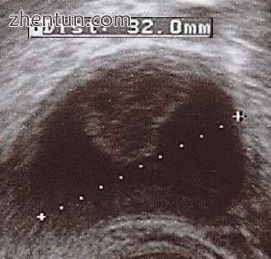黄体囊肿是一种卵巢囊肿,可能在月经来临时破裂,需要长达三个月才能完全消失。 黄体囊肿很少发生在50岁以上的女性中,因为绝经后卵子不再被释放。 黄体囊肿可能含有血液和其他液体。 黄体囊肿的物理形状可能表现为卵巢本身的增大,而不是卵巢表面明显的肿块状生长。

黄体囊肿伴出血。新鲜血液是无回声的(黑色)。囊肿顶部还可见凝固的血液(颜色较浅)突出。
目录
1 症状和体征
2 病理生理学
3 与药物的相互作用
4 参考
体征和症状
然而,黄体囊肿可以长到直径近10厘米(4英寸),有可能自行流血或扭曲卵巢,导致盆腔或腹部疼痛。如果它充满血液,囊肿可能会破裂,导致内出血和剧烈疼痛。这种疼痛会在破裂后的几天内消失。很少,它可能导致卵巢扭转卵巢韧带,并切断血液流向卵巢。这被称为卵巢扭转并引起疼痛和其他症状。
病理生理学
这种类型的功能性囊肿发生在卵子从卵泡中释放出来之后。然后卵泡变成分泌腺,称为黄体。破裂的卵泡开始产生大量的雌激素和黄体酮以准备受孕。如果没有发生怀孕,黄体通常会分解并消失。然而,它可能充满液体或血液,导致黄体扩张成囊肿,并留在卵巢中。通常,这个囊肿只在一侧,并不会产生任何症状。[1] [2]
在育龄妇女中,直径小于5厘米的囊肿很常见,临床上无关紧要,几乎总是生理状况,而不是癌症或其他疾病。[3] 在绝经后的女性中,关注的阈值是1厘米。[3] 虽然卵巢癌是囊性的,但它不是由良性黄体囊肿引起的。[3] 医学专业的专业组织建议不要对囊肿进行随访成像,这在临床上是无关紧要的。[3]
与药物相互作用
用于诱导排卵的生育药物克罗米芬柠檬酸盐(Clomid,Serophene)增加了排卵后黄体囊肿发生的风险。 这些囊肿不能预防或威胁由此引起的妊娠。[4] [5] 服用避孕药的妇女通常不会形成这些囊肿; 事实上,预防这些囊肿是避孕药的一种工作方式。[6] 相反,仅黄体酮药丸可引起这些囊肿的频率增加。
参考:
"Ovarian Cysts: What You Need to Know about an Ovarian Cyst and PCOS".
"Corpus luteum cyst". Uni. Utah: Knowledge Weavers: Human Reproduction.
American College of Radiology, "Five Things Physicians and Patients Should Question" (PDF), Choosing Wisely: an initiative of the ABIM Foundation, American College of Radiology, archived from the original (PDF) on April 16, 2012, retrieved August 17, 2012, citing
Levine, D.; Brown, D. L.; Andreotti, R. F.; Benacerraf, B.; Benson, C. B.; Brewster, W. R.; Coleman, B.; Depriest, P.; Doubilet, P. M.; Goldstein, S. R.; Hamper, U. M.; Hecht, J. L.; Horrow, M.; Hur, H. -C.; Marnach, M.; Patel, M. D.; Platt, L. D.; Puscheck, E.; Smith-Bindman, R. (2010). "Management of Asymptomatic Ovarian and Other Adnexal Cysts Imaged at US: Society of Radiologists in Ultrasound Consensus Conference Statement". Radiology. 256 (3): 943–954. doi:10.1148/radiol.10100213. PMID 20505067.
American College of Obstetricians and Gynecologists (2002). "ACOG Committee Opinion: Number 280, December 2002. The role of the generalist obstetrician-gynecologist in the early detection of ovarian cancer". Obstetrics and gynecology. 100 (6): 1413–1416. doi:10.1016/S0029-7844(02)02630-3. PMID 12468197.
&Na; (2007). "ACOG Practice Bulletin No. 83: Management of Adnexal Masses". Obstetrics & Gynecology. 110 (1): 201–214. doi:10.1097/01.AOG.0000263913.92942.40. PMID 17601923.
Timmerman, D.; Valentin, L.; Bourne, T. H.; Collins, W. P.; Verrelst, H.; Vergote, I.; International Ovarian Tumor Analysis (IOTA) Group (2000). "Terms, definitions and measurements to describe the sonographic features of adnexal tumors: A consensus opinion from the International Ovarian Tumor Analysis (IOTA) group". Ultrasound in Obstetrics and Gynecology. 16 (5): 500–505. doi:10.1046/j.1469-0705.2000.00287.x. PMID 11169340.
"Ovarian cysts: Causes". Mayo Clinic.
"Corpus luteum cyst". Mayo Clinic.
Hill DA. "Photos of the Ovaries". Women's Health Information. Archived from the original on March 21, 2007. |